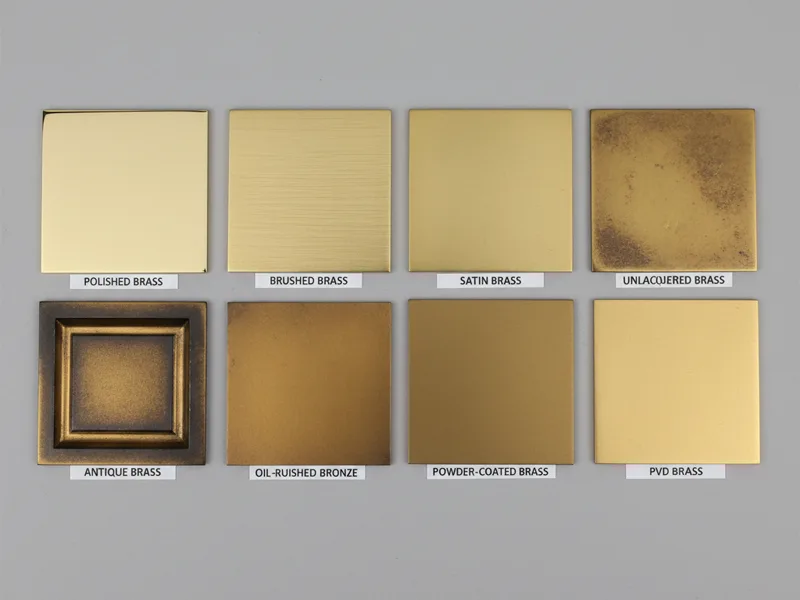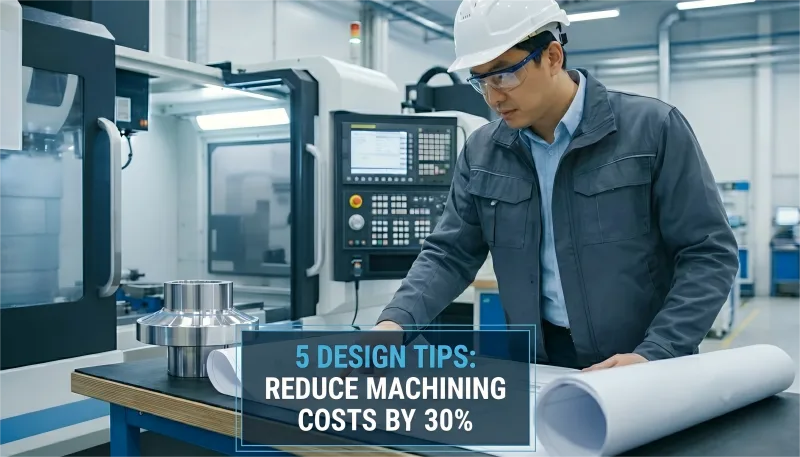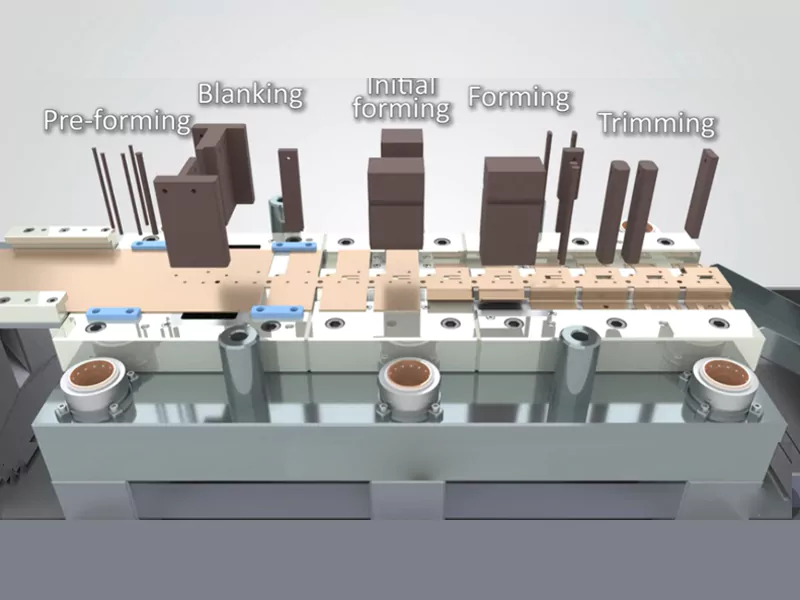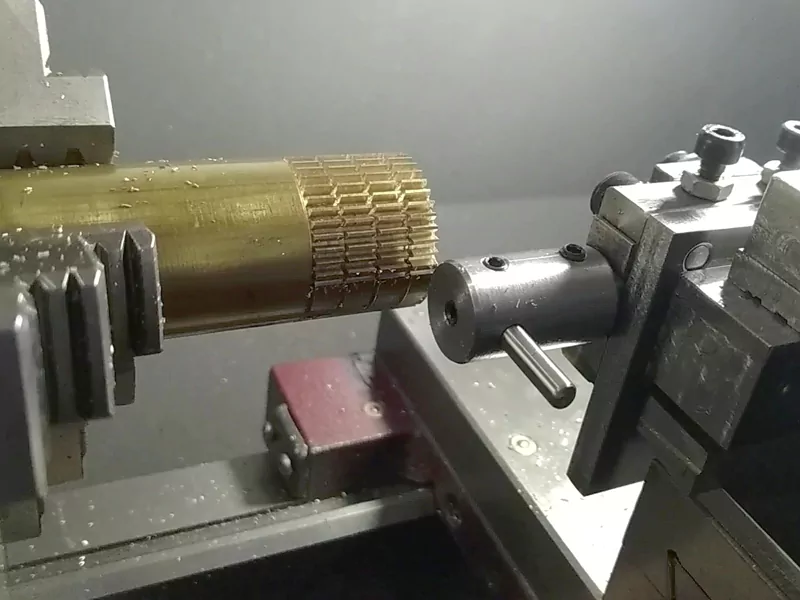You will learn how brass finishing changes plain things into cool items. Brass finishing uses special steps to make things look better and work well. Many experts pick brass because it looks nice and lasts a long time. You see brass a lot in home decorations and fashion items since it makes things look fancy and cozy. Brass finishing helps make projects cheap and easy to use every day. Think about which finish fits your project’s needs and style.
Key Takeaways
- Brass finishing makes brass look better and last longer. It helps brass work for many kinds of projects.
- Pick the best brass finish for your project’s place. Think about how much cleaning you want to do. This helps brass last long and look good.
- Polished brass is shiny but needs lots of cleaning. Satin brass does not need much cleaning and hides marks.
- Try eco-friendly choices like recycled brass. Use finishes that stop rust, like powder-coated or PVD brass, for green projects.
- Do not make mistakes by picking the wrong brass finish. Match the finish to how you clean and where you use it.
Table of Contents
Brass Finishing Overview
Brass finishing means using special steps to make brass look better and last longer. You can polish the surface to create a shiny layer. This process not only makes brass beautiful but also protects it from rust. When you use brass finishing, you help your project stay strong and look good for many years. Many people choose brass for modern projects because it stands up to wear and tear.
Benefits
Brass finishing gives you more than just a pretty look. It helps your project last longer and work better.
- Brass works well in traditional spaces, adding warmth and style.
- You can use brass to give modern rooms a unique twist.
- Brass fits in with many other metals, making it great for mixed designs.
- It develops a special patina over time, giving each piece character.
- You can polish brass to a high shine or let it age for a softer look.
Here are some reasons why you might pick brass for your project:
- Brass fixtures rarely need replacement because they resist wear.
- They keep their good looks even when styles change.
- You can restore brass instead of buying new pieces.
- Brass is highly durable and resists corrosion.
- It can last for decades with only simple cleaning.
Brass is also a smart choice for the planet. You can recycle it many times without losing quality. Using recycled brass helps lower the impact on the environment.
Applications
You will find brass finishing in many industries. Some of the most common include:
- Aerospace
- Automotive
- Electronics
- Medical
- Telecom
Brass is also popular in home décor, lighting, and furniture. You can use it for handles, faucets, and even jewelry. Because brass resists rust, it works well in places that get wet or need to stay clean. Regular cleaning keeps brass looking new and helps it last even longer. When you choose high-quality brass, you get better protection against damage and a longer life for your project.
Types of Brass Finishes
When you look at different brass finishes, you find many choices. Each finish makes brass look and feel special. You can pick a finish that matches your style and project. Some finishes are easy to care for and last a long time.
Polished Brass
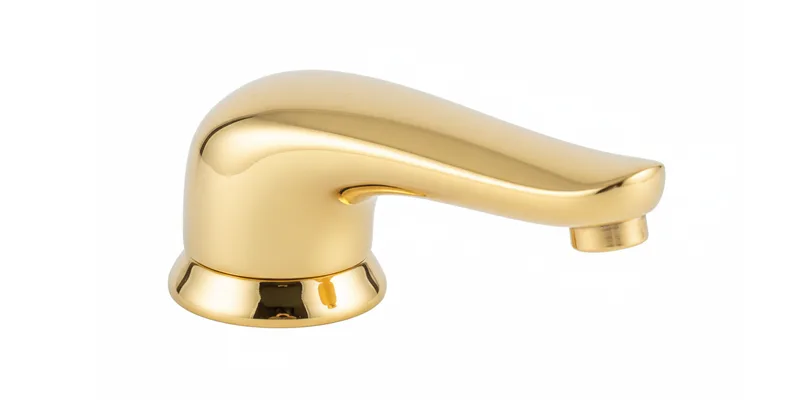
Polished brass has a bright gold color and shines a lot. Its surface is smooth and reflects light well. This finish looks good in old and new rooms. People use polished brass in bathrooms, kitchens, and living rooms. It fits with many colors and styles. You can use it to stand out or blend in.
- Shiny, reflective surface
- Bright gold color
- Smooth and glossy
- Looks fancy in many designs
- Needs cleaning to remove fingerprints and spots
Tip: Polished brass looks rich and never goes out of style. Wipe it often to keep it shiny and clean.
You see polished brass on faucets, cabinet handles, and lights. It works with many colors and materials. This makes it a favorite for modern projects.
Antique Brass
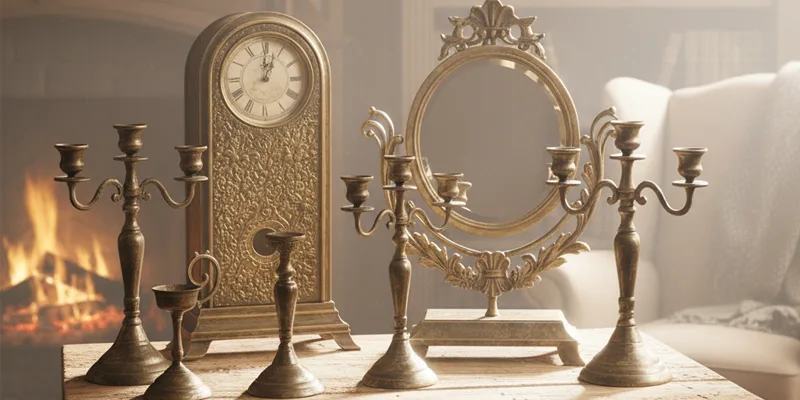
Antique brass gives things a warm, old look. It has a dark, uneven patina that makes each piece special. Makers use chemicals to darken the brass. They remove any coating, add a dark solution, and seal it to keep the look.
- Dark, aged patina
- Warm, old-fashioned style
- Made by chemical oxidation
Antique brass adds charm and character to rooms. It looks great with wood and makes spaces feel cozy.
| Application Type | Description |
|---|---|
| Interior Design | Antique brass feels warm and rich, so it is a classic choice for decor. |
| Hardware | Old-style cabinet pulls and shelf brackets give furniture a vintage look. |
| Accessories | Lamps and candlesticks in antique brass make simple rooms look special. |
Antique hardware is more than just old. It shows skill, history, and style. Adding antique brass to furniture or doors makes your space unique and full of memories.
Satin Brass
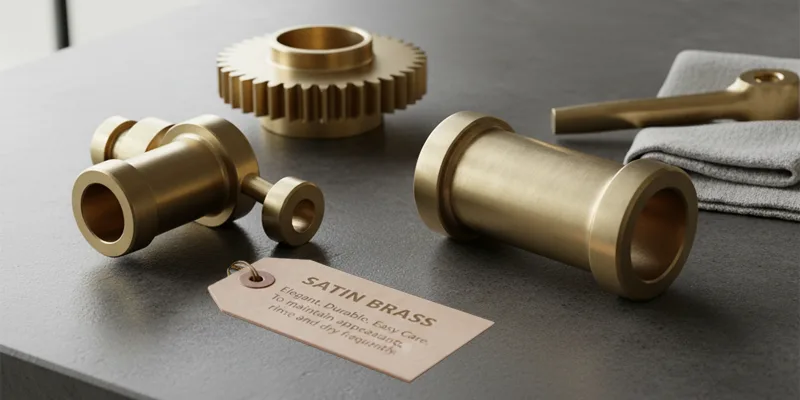
Satin brass has a soft look that is not too shiny. It feels rich but not flashy. Makers brush the brass to make it smooth and even.
- Looks nice
- Strong surface
- Easy to care for
Satin brass needs cleaning to stop spots and stains. Rinse and dry it often to keep it nice. Many people like satin brass for its modern look and simple care.
Brushed Brass
Brushed brass is warm gold with a soft shine. You see fine lines going one way from brushing. This finish spreads light and hides small marks. Brushed brass is tough and does not rust easily.
- Warm gold color with soft shine
- Fine lines in one direction
- Hides small scratches and fingerprints
- Strong and resists rust
You find brushed brass on kitchen handles and modern furniture. It adds warmth and style to new spaces. Many designers like brushed brass more than shiny finishes for a fresh look.
Electroplated Brass
Electroplated brass uses electricity to cover metal with a thin brass layer. This makes items look better and stronger. It helps stop rust, gives a special finish, and lasts longer. Electroplated brass also saves money and keeps electricity flowing.
- Adds a strong layer
- Stops rust
- Gives a special look
- Keeps electricity moving
You see electroplated brass on door handles, faucets, and hardware. The finish protects against rubbing, bumps, and chemicals. Heavy use can wear it down over time.
PVD Brass
PVD brass means Physical Vapor Deposition. This new way puts a thin, hard coat on brass. PVD is better for the planet because it uses no bad chemicals. New technology makes PVD brass strong and useful.
- Good for the environment
- Tough, lasting coat
- Cleaner than old ways
PVD brass is often used with electroplating to work better. You find PVD brass in fashion, hardware, and home items. It comes in many colors and finishes and protects the brass.
Powder Coated Brass
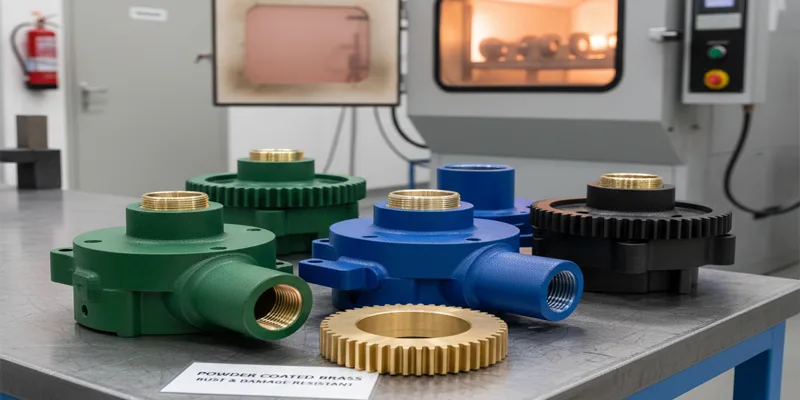
Powder coated brass uses dry powder that sticks to electricity. The item is baked in an oven to set the coat. This finish is thicker and stronger than paint. Powder coated brass does not scratch, chip, or fade easily.
- Many finishes to choose from
- Protects from rust and damage
- Even color and texture
- Safer and less flammable than wet paint
| Application Type | Description |
|---|---|
| Architectural and Decorative Elements | Used for railings, handles, and trims in fancy designs because it lasts and looks good. |
| Furniture and Home Decor | Found on cabinet handles and lights, mixing style and protection. |
| Automotive Industry | Makes car parts look better and stops rust. |
| Electrical and Electronics | Keeps connectors safe from water and lets electricity flow. |
| Industrial Equipment | Used on machines to last longer in tough places. |
| Marine Applications | Boat parts are coated to handle salty water. |
| Plumbing and Bathroom Fixtures | Used on faucets and accessories for looks and rust protection. |
| Lighting Fixtures | Used for frames and covers, giving strength and finish choices. |
| Art and Sculptures | Artists use it for weatherproof art with special looks. |
| Jewelry and Accessories | Gives cool colors to fashion pieces, but not used a lot. |
| Consumer Goods | Found on home appliances and kitchen tools. |
| Military and Aerospace | Coated to survive tough conditions and still work. |
Powder coated brass is good for any project that needs a strong, colorful, and lasting finish.
Unlacquered Brass
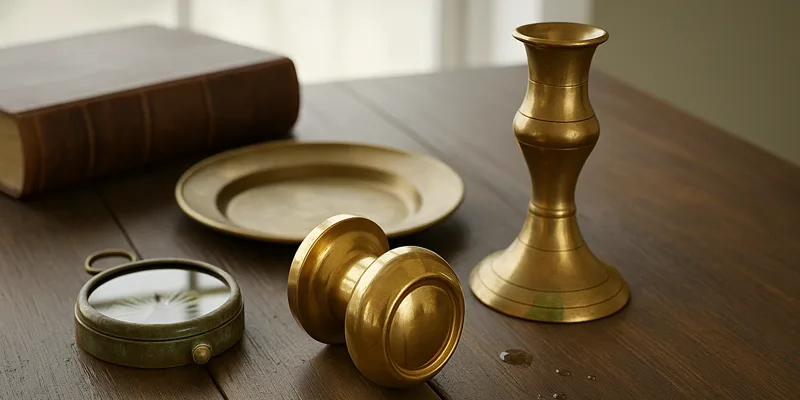
Unlacquered brass has no protective coat. This finish lets the brass change naturally. Over time, it gets a patina that makes each piece special. The patina forms when brass touches air, water, and oils from hands.
- No protective coat
- Gets a special patina over time
- Strong and does not rust
- Changes color with use and air
Unlacquered brass starts shiny and bright. As you use it, it gets darker and more interesting. Many people like it because it tells a story and fits any style. You can polish it to make it shiny again or let it age for a softer look. If you want a finish that changes as you use it, unlacquered brass is a great pick.
Note: Unlacquered brass needs more care if you want it shiny. If you like a natural look, let it age by itself.
When you know about brass finishes, you can choose the best one for your project. Each finish has its own good points, from easy care to special style. Try these finishes to find what works for you.
Comparing Brass Finishes
When you choose a brass finish for your project, you want to know how it will last, how much care it needs, and if it fits your style. Each finish has its own strengths. Let’s look at the main points to help you decide.
Durability
Some brass finishes stand up to daily use better than others. For example, PVD brass keeps its shine for years and resists tarnish. Polished brass looks bright but can lose its shine if you do not clean it often. Unlacquered brass changes over time and forms a patina, but it stays strong. Antique brass also develops a patina, which hides small marks and makes it look better as it ages.
| Finish Type | Characteristics | Maintenance Requirements |
|---|---|---|
| Polished Brass | Shiny, clear lacquer can tarnish | Needs regular polishing |
| Unlacquered Brass | Rich patina, changes naturally | Needs little upkeep |
| PVD Brass | Long-lasting, tarnish-resistant, keeps shine | Needs little upkeep |
Tip: If you want a finish that lasts in wet or outdoor places, pick one with a strong coating like PVD or powder coated brass. These finishes protect against rust and fading.
Maintenance
You want a finish that fits your lifestyle. Some finishes need more care than others. Polished brass needs frequent cleaning to stay shiny. Satin brass hides fingerprints and scratches, so you clean it less. Antique brass and unlacquered brass need only simple cleaning, and you can let them age for a unique look.
| Finish Type | Maintenance Requirement |
|---|---|
| Polished Brass | Needs frequent cleaning and special products |
| Satin Brass | Low-maintenance, hides marks well |
| Antique Brass | Needs simple cleaning, patina hides wear |
| Unlacquered Brass | Needs only mild soap and water |
You can clean most brass with mild soap and water. You do not need special cleaners. If you want to restore shine, you can polish it.
Design Suitability
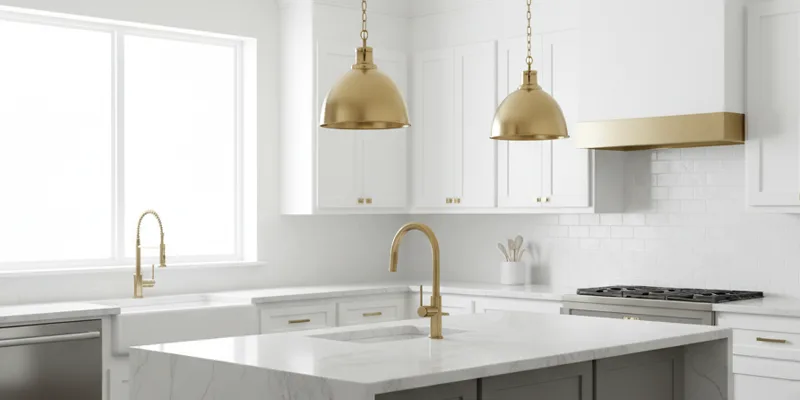
Brass finishing gives you many choices for style. Antique brass works well in classic or vintage rooms. It adds warmth and character. Polished brass fits modern and traditional spaces with its bright look. Satin and brushed brass give a soft, modern feel. PVD and powder coated brass come in many colors, so you can match any design.
Note: For outdoor or humid spaces, use premium brass with a protective coating. This helps your project last longer and keeps it looking good.
When you compare brass finishes, think about how you will use the item, how much care you want to give, and what style you like best. This helps you pick the right finish for your needs.
Choosing Brass Finishing
Selection Tips
You want your project to look great and last a long time. Picking the right brass finish helps you reach that goal. Start by thinking about where you will use the brass. If you plan to use brass in a bathroom or kitchen, choose a finish that resists water and stains. Powder coated and PVD brass work well in wet places because they protect against rust and fading.
You should also consider how much time you want to spend on cleaning. Satin and brushed brass hide fingerprints and scratches, so you clean them less often. Polished brass looks bright but needs regular care to stay shiny. If you like a finish that changes over time, unlacquered brass develops a patina and tells a story.
Experts suggest using progressive polishing and buffing for a high-gloss look. You can use fine abrasives, buffing wheels, or hand polishing to restore brass brilliance. For small parts, tumbling with the right media gives a smooth finish. If you need to drill brass, clean the surface first and use low speed with cooling fluid. After drilling, use deburring tools and fine sandpaper for a smooth edge.
Tip: Always match the brass finish to your project’s needs and your cleaning habits. Regular upkeep keeps brass looking new and strong.
Common Mistakes
Many people make mistakes when choosing brass finishes. You can avoid these problems by following simple steps.
- Forgetting to think about the environment where you will use the brass.
- Picking a finish that needs more care than you want to give.
- Using harsh cleaners that damage the brass surface.
- Not dusting or washing powder-coated brass often enough.
- Skipping post-processing steps like deburring or polishing.
Here is a table with maintenance tips for popular brass finishes:
| Finish Type | Maintenance Tips |
|---|---|
| Polished Brass | Use mild brass cleaner and a soft cloth; apply lacquer to slow tarnishing. |
| Satin Finishes | Wipe with a damp microfiber cloth—no harsh chemicals. |
| Powder-Coated & Matte | Dust regularly, and wash with mild soap. |
Choosing polished brass can be tricky because it shows fingerprints and tarnishes easily. You can use non-abrasive car wax and metal polishing cloths to keep it shiny. Always clean brass with gentle products to avoid scratches.
Note: Regular upkeep and the right cleaning methods help your brass finishing last longer and look better.
You have seen many brass finishing techniques, and each one is special. The table below lists finishes like Wiltshire and Somerset. These finishes make furniture and walls look stylish.
| Finish Type | Description | Applications |
|---|---|---|
| Wiltshire finish | Distressed feel | Interior design, furniture |
| Berkshire finish | Weathered look, unique patina | Decorative pieces, fixtures |
| Cambridgeshire finish | Milled luxury | Walls, statement pieces |
| Somerset finish | Vibrant aged patina | Unique decor |
| Natural brass finish | Light, can change patina | Versatile design |
You should look at how easy each finish is to care for. Think about the style and how long it will last. Try out samples or talk to experts for help. There are many guides and services that can help you choose the best finish for your project.
FAQ
Satin brass is the easiest to keep clean. You can wipe it with a damp cloth. It hides fingerprints and scratches. You do not need special cleaners.
You can use powder coated or PVD brass outside. These finishes protect against rain and sun. They stop rust and fading. Always check the product label for outdoor use.
You can clean tarnished brass with mild soap and water. Use a soft cloth to rub the surface. For tough spots, try a gentle brass polish. Avoid harsh chemicals.
Brass finishing makes items last longer. Strong coatings like PVD and powder coating protect against scratches and rust. You get better performance and longer life.
You should pick powder coated or PVD brass for kitchens. These finishes resist water and stains. They stay bright and clean with simple care.


